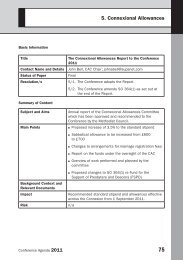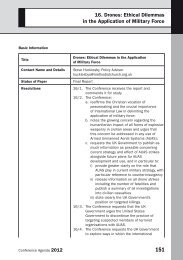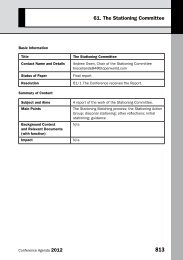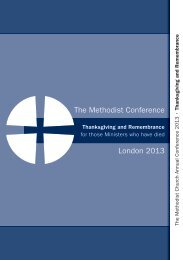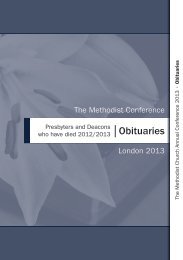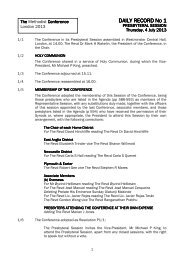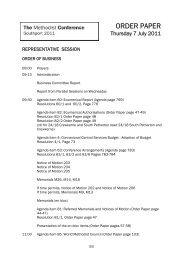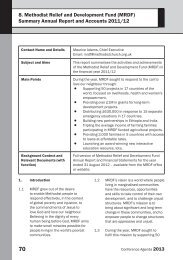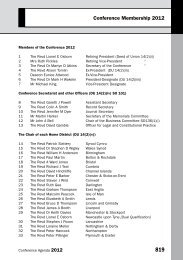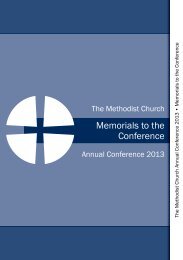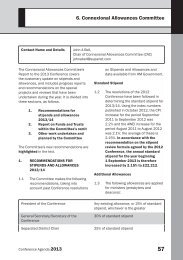Agenda Volume 3 - Methodist Conference
Agenda Volume 3 - Methodist Conference
Agenda Volume 3 - Methodist Conference
Create successful ePaper yourself
Turn your PDF publications into a flip-book with our unique Google optimized e-Paper software.
57. The Fruitful Field Project<br />
be creatively envisaged in different<br />
places across the Connexion,<br />
particularly if the majority of<br />
learning does not happen at the<br />
single hub location... Experience of<br />
blended learning... has highlighted<br />
the limitations of solely relying on<br />
tutorials via Skype and occasional<br />
weekend residential courses for<br />
those training for ministry.” A partner<br />
organisation’s submission noted that<br />
“we affirm the need for ‘quiet restful<br />
places’ where space and time can be<br />
offered for theological reflection and<br />
where events can take place which<br />
encourage and enrich the discipleship<br />
life of the <strong>Methodist</strong> people.”<br />
189 The establishment of such “quiet,<br />
restful places” where learners and<br />
participants can gather is not an alien<br />
concept for the <strong>Methodist</strong> people.<br />
Local Churches are themselves,<br />
by their very nature and purpose,<br />
gathering spaces for formation,<br />
learning and development. Many<br />
Circuits and Local Churches<br />
are investing in adaptations to<br />
existing premises, or in building<br />
new premises, which are better<br />
configured as environments for study<br />
and sharing. Within some Districts,<br />
larger churches, central halls or other<br />
notable buildings within the life of<br />
the District are already developing<br />
as gathering spaces for formation,<br />
learning and development serving<br />
a wide area. Development plans<br />
being explored by the trustees of<br />
the New Room, Bristol include the<br />
potential for developments on the<br />
site to create intentionally appropriate<br />
space for study and sharing, with the<br />
necessary ancillary facilities to make<br />
the experience of gathering for study<br />
and sharing both comfortable and<br />
attractive.<br />
190 It is therefore already possible to see<br />
ways in which a recommendation by<br />
the Committee to identify appropriate<br />
gathering spaces for formation,<br />
learning and development can<br />
draw on existing experience and<br />
developments, and on a willingness<br />
across the Connexion to use our<br />
premises more strategically as a key<br />
resource for mission and growth.<br />
191 Drawing on the developments already<br />
explored by some Districts, it is<br />
possible to imagine learning and<br />
gathering spaces being developed<br />
alongside District administration<br />
hubs, so that the gathering space can<br />
be used for a multitude of purposes<br />
within the life of the District or region.<br />
Drawing on the experience of the<br />
explorations being undertaken by the<br />
trustees of the New Room, it is also<br />
possible to imagine the development<br />
of gathering spaces in the historic<br />
bases of Bristol and London, for<br />
instance, which draw on the rich<br />
opportunities to establish links<br />
between the learning space and the<br />
history of Methodism, emphasising<br />
the spiritual and relational aspects<br />
of gathering spaces as well as their<br />
more functional purposes.<br />
192 As those who act as managing<br />
trustees for a range of premises<br />
across the Connexion realise, spaces<br />
<strong>Conference</strong> <strong>Agenda</strong> 2012 721



